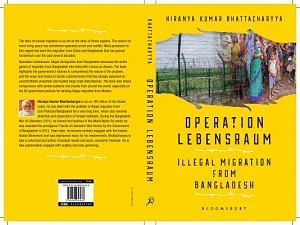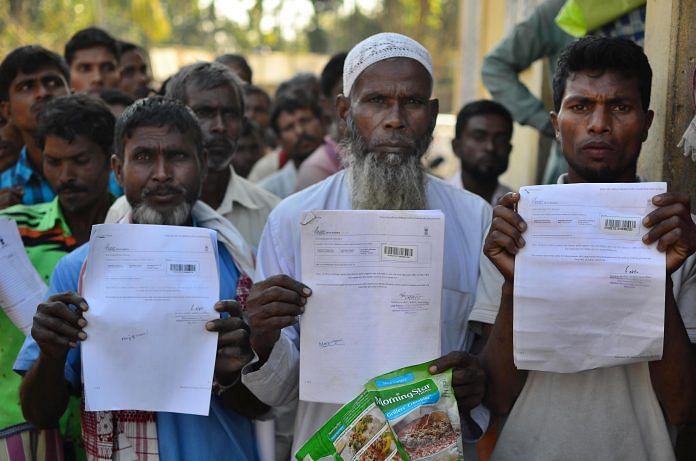Former IPS officer Hiranya Bhattacharyya’s book comes at a time when Assam is once again on the edge over NRC update and the controversial citizenship bill.
Illegal immigration is a sensitive issue in Assam and any discussion on this topic requires a spatio-temporal interpretation of the problem that has its roots in the colonial period.
That Assam has been overburdened with illegal immigrants and refugees from the erstwhile East Pakistan, later Bangladesh, is an issue that has been raised, argued and debated for decades. There have been warnings galore since independence, when the venerable Assam chief minister Gopinath Bordoloi repeatedly requested Prime Minister Jawaharlal Nehru to distribute the excess population, only to be rebuked and warned.
Even years later, the government never bothered to implement the Assam Accord (1985), the signing of which had brought to an end the historic six-year agitation against foreign nationals in the state.
Then came the judgment by the Supreme Court in 2005, striking down the controversial Illegal Migrations Determination by Tribunals (IMDT) Act that had almost made it impossible to detect illegal immigrants. There was also a glaring report submitted by former Assam governor Lt Gen (retd) S.K. Sinha to the Centre in 1998, which not only raised an alarm over the continuous infiltration from the neighbouring country but detailed a list of preventive steps to be implemented to check the deteriorating situation.
And now, two decades later, the state is once again on the edge over the update of the National Register of Citizens (NRC) and the controversial Citizenship Amendment Bill, which seeks to grant citizenship to religious minorities, including Hindus from Bangladesh and a few other countries.
The process of updating the NRC is on, and upon its completion, it is quite likely that an explosive situation may surface. In this context, former IPS officer Hiranya Kumar Bhattacharyya’s Operation Lebensraum: Illegal Migration from Bangladesh proves to be a timely publication.
The term lebensraum was coined by German geographer Friedrich Ratzel (1844-1904), which means “living space”, and according to which, the development of all species, including humans, is primarily determined by their adaptation to geographic circumstances. Adolf Hitler justified the idea to annex territories in eastern Europe and Russia.
In the context of Bangladesh, which is spread over 1,47,570 sq kms, the idea appears to be first propounded by its founder Sheikh Mujibur Rahman, who wrote in his book Eastern Pakistan: Its Population and Economics that Assam must be included in East Pakistan to be financially and economically strong.
Bhattacharyya’s book offers an insider’s perspective into the phenomenon of illegal immigration into Assam, how it remained unchecked for decades, and the government’s utter failure in ushering in preventive measures. The book also refers to the trends of illegal migration in the other parts of India’s eastern region, and across the globe.
Bhattacharyya belonged to the 1958 IPS batch of the Assam cadre. His efforts at identifying and deporting illegal immigrants invited the ire of a section of Congress politicians, who soon hatched a conspiracy to get him detained under the National Security Act (NSA) in 1981.
After unravelling that more than a lakh illegal Bangladeshi immigrants (both Hindus and Muslims) had enrolled in the voters’ list in Dalgaon constituency, he brought the matter to the notice of the government. Although the government was unable to swing into action, the issue provided fodder for the All Assam Students’ Union to underscore the danger from what was seen as ‘a silent invasion’. Within a few months, the historic Assam Agitation was launched, which led to signing of the Assam Accord in 1985.
The author has highlighted how ruling parties, both at the Centre and in the state, have turned the entire issue into “vote bank” politics. Bhattacharyya has also questioned the Election Commission’s role, and blamed it for suspected distortion of electoral rolls of Assam, quoting relevant data. In fact, the historic Assam Movement centred round the distortion of electoral rolls.
The author has depicted the situation in the Western countries where the demands for both skilled and unskilled workers are being met by migrants. According to Bhattacharyya, while American and EU authorities have adopted a very rational attitude to the entire gamut of issues involved in the massive illegal human migration, India has so far failed to chalk out any distinct policy in this context.
However, it has been very pertinently pointed out that a parallel cannot be drawn between Mexican/Chinese immigration and Bangladeshi influx. The author argues that the emergence of Jihadi elements has imparted a more complicated texture to the entire phenomenon, thereby highlighting the fundamentalist efforts for materialising the concept of a “grater Islamic nation”. He has pointed out how eastern and northeastern region has been converted into “breeding grounds of Islamic terrorists”.
The author has also visualised the shape of things to come and suggested some novel ways to deal with the problem.
 ‘Operation Lebensraum: Illegal Migration from Bangladesh’ by Hiranya Bhattacharyya has been published by Bloomsbury.
‘Operation Lebensraum: Illegal Migration from Bangladesh’ by Hiranya Bhattacharyya has been published by Bloomsbury.






